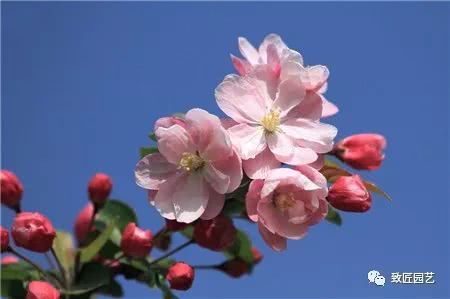Production and Management of Apple Bonsai

Apple is delicious and delicious, and it is one of the fruits often eaten in daily life. Its peel is smooth and colorful. It can not only be used for food, but also make bonsai. Apple is a deciduous tree of Rosaceae, with many varieties, up to 5 meters high, young branches with gray-white tomentose, old branches glabrous, according to different varieties, branches have gray-brown, yellow-brown, purplish red and other colors. The leaf is oval to wide oval, the leaf color gradually changes from yellow-green to dark green, there are many different degrees of green in the middle, and the leaf margin is sawtooth and obtuse. Corymbose inflorescences with pale pink or white flowers blooming in spring. The fruit has many forms, such as oblate ball, ovate, table, five edges and so on. After ripening, there are different colors such as yellow, red, purple and so on. Today, I would like to introduce to you the production and management of Apple bonsai. I hope you can learn it together.
The apples used to make bonsai can choose those varieties with small plants, early fruiting, strong self-pollination ability, moderate fruit size and bright colors. Use seedlings of begonia, bauhinia or apple as rootstocks and scions with strong branches or plump buds slightly above the middle? Grafting is carried out by means of split grafting, cutting grafting and budding grafting. Can also be used for many years of growth, strange and elegant shape of the old pile as rootstock, 1-3-year-old branch group as scion, grafting, this method can not only speed up the forming speed, but also bear fruit ahead of time. The transplanting of rootstocks is carried out before sprouting in spring or after defoliation in autumn, first planted in a mud basin of suitable size, and properly pruned before planting, cutting off branches that are not needed in modeling, so as to reduce nutrient consumption and improve the survival rate. The root system should also be pruned, the thick main root should be cut off, and the lateral root and whisker root should be retained. The root with suitable thickness and length can be put into the basin first to prepare for the later root lifting. It is allowed to grow in the first year after survival, so that the branches are fully developed and the root system is perfect. Grafting will be carried out in the second year and the branches on the rootstock will be cut off to ensure that there are sufficient nutrients for the growth of the scion.
According to the shape of the stump, apples can be made into many different forms of bonsai, such as straight dry type, curved dry type, double dry type, oblique dry type, horizontal dry type, root raising type and so on. For young trees, the trunk can be modeled to make it tortuous and flexible. For the stump that lacks the state of aging, the method of splitting, carving or planing can be used to deal with the trunk in order to achieve a clear and quaint artistic effect.
Apple branches are soft and resilient, and can be banded to 1-3-year-old branches in May every year to make them bend to a certain extent. because the branches grow downward or extend in parallel, the tip advantage can be removed. so that the plant gradually from vegetative growth to reproductive growth, which is conducive to the formation of flower buds. The root can also be raised according to the needs of modeling and the variety of rootstock, in which the apple bonsai grafted with Arbor-like rootstock is especially suitable for making root-lifting bonsai because of its developed and sturdy root system. Root lifting should be carried out year by year, step by step, and can not be completed at once. Fresh roots with suitable shape, thickness and length can also be selected and grafted by subcutaneous grafting. Make the roots natural, vigorous and simple.
Apple is a temperate tree species, like cool, dry and sunny environment, resistant to cold, afraid of hot and humid. During the growing period, it can be maintained in a sunny and well-ventilated place. if the light is not enough, the color, quality and plant shape of the fruit will be affected. Because the self-pollination of most apple varieties is very low, in order to improve the fruit setting rate, different varieties of pollen can be used for artificial pollination at flowering stage. In order to balance the tree potential and make different branches bear fruit in turn, it is also necessary to thinning flowers and fruits, so as to improve the ornamental effect and prevent the occurrence of big and small years. Watering during the growing period should be "dry and thoroughly" to avoid stagnant water in the basin soil. When flower buds begin to differentiate in June, watering should be strictly controlled for more than 20 days, and young leaves should be watered again when they wilt, so as to promote the formation of flower buds. During the growing period, fertilizer was applied every 20 to 30 days, mainly nitrogen fertilizer in the early stage, but stopped or less nitrogen fertilizer, more phosphorus and potassium fertilizer and trace elements such as calcium and magnesium after June. In the growing period of the branch, the tender tip at the top should be removed in time to prevent the branch from lengthening and redistribute nutrients. These measures can enrich the development of the branch, be conducive to the formation of flower buds, achieve the purpose of multi-fruit and improve fruit quality.
Apple is afraid of high temperature. the high temperature of more than 35 ℃ in summer will cause the branches to grow excessively and the fruit quality will decline. It is necessary to strengthen ventilation and shade properly to reduce the temperature. In winter, move to the ℃ to 10 ℃ indoor winter, or bury the flowerpot in the outdoor shelter from the wind and the sun. Pruning and shaping the plant once a year before sprouting in winter or spring, cutting off diseased branches, overlapping branches, overgrown branches and over-dense branches, and truncating overlong branches to maintain the beauty of the tree. The pots were changed every 2 to 3 years after defoliation in autumn or before sprouting in spring. When changing pots, the roots were arranged and trimmed, and the old soil was removed and replaced with loose, fertile and humus-rich newly cultured soil.
Wonderful content
- Prev

The making method of crabapple bonsai
Make crabapple bonsai, often use a deep rectangular or oval basin, of course, you can also choose a square or round basin according to your personal preference. If it is a cliff type, you can choose a deep thousand-cylinder basin. The material of the basin can be dead purple sand or glaze.
- Next

Jiang is an old hot old man who flirted with a liar on the phone for five hours, and finally the swindler fainted.
Uncle Liu, who lives in Renan District of Suzhou, recently received a phone call from a stranger claiming to be from the Public Security Bureau. "I wonder why the Public Security Bureau called me. I pressed it the first time. " But within a minute, the phone rang again. Yes.。
Related
- Wuhan Hospital Iron Tree Blooming Result Was Instantly Frightened by the Gardener Master
- Which variety of camellia is the most fragrant and best? Which one do you like best?
- What is the small blue coat, the breeding methods and matters needing attention of the succulent plant
- Dormancy time and maintenance management of succulent plants during dormancy
- Minas succulent how to raise, Minas succulent plant pictures
- What are the varieties of winter succulent plants
- How to raise succulent plants in twelve rolls? let's take a look at some experience of breeding twelve rolls.
- Attention should be paid to water control for succulent plants during dormant period (winter and summer)
- Watering experience of twelve rolls of succulent plants
- Techniques for fertilizing succulent plants. An article will let you know how to fertilize succulent plants.

